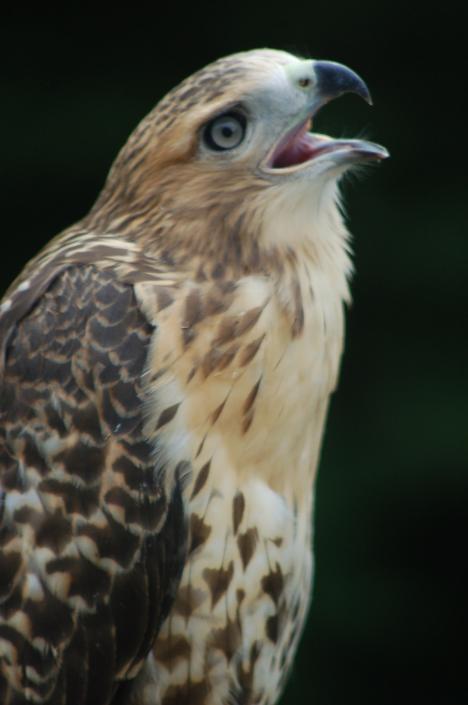New England Hawk Migration | Watching the Skies
Each fall, as thousands of raptors fly southward over New England, hundreds of volunteers watch and keep count. On a cold October morning at Lighthouse Point in Connecticut, Bill Banks stands in an open field and squints into a brightening sky. The distant roar of traffic along the I-95 corridor washes over him. The sun, […]

A Red Tail Hawk in West Simsbury, CT.
Photo Credit : Rosemary R. SmithEach fall, as thousands of raptors fly southward over New England, hundreds of volunteers watch and keep count.
On a cold October morning at Lighthouse Point in Connecticut, Bill Banks stands in an open field and squints into a brightening sky. The distant roar of traffic along the I-95 corridor washes over him. The sun, coming up behind the condominiums bordering the park, glints off the underside of a small plane heading out of Tweed-New Haven Airport. It’s not a place you’d immediately pick for observing nature.
Lighthouse Point sits on a coastal plain along the southeastern edge of New Haven Harbor, jutting out into Long Island Sound. In the fall, thousands of migrating raptors pass overhead, leery of crossing open water, hugging the Atlantic seaboard as they funnel south toward Mexico.
Photo Credit : Jane Ogilvie
Today is Bill Banks’s day. He’s been one of the Lighthouse Point counters for half a dozen years, every Tuesday from September through November, rain or shine. When he’s lucky, it’s the second or third day after a cold front has passed through, and clearing northwest winds have released kestrels and red-tailed hawks, sharp-shinned and Cooper’s hawks, that had hunkered down in the bad weather.
Above the ridgelines farther inland, kettles of broad-winged hawks–the most impressive sight of the migration–will ride those same fair winds. Today is one of those days. Banks looks up at a flawless sky and at a string blowing out from a small maple tree nearby, and estimates a 2 on the Beaufort scale, steady out of the north/northwest.
Photo Credit : David Luppold
A small flock of cedar waxwings wheels along the northern border of the field, flashing sunlight, catching Bill’s attention but not his interest. “We don’t count waxwings,” Banks says. “Not starlings, not gulls. They’re resident.”
But then a larger movement crosses the northeastern sky. Banks looks up and takes only a few seconds to count 49 Canada geese, honking as they go. That will be part of the day’s count, recorded by the hour along with weather and wind data and entered into databases at the Web sites hawkcount.org and eBird.org. Several “sharpies” soon follow, then, yes, a kestrel–then a few minutes later a peregrine, and then, over there, a flock of redwing blackbirds.Banks lifts binoculars to confirm the kestrel, though he doesn’t really need to. This early in the morning, the birds are still flying low enough to be identified and counted with the naked eye, though they can sometimes be tough to see against a clear blue sky. “You can look at pictures in books,” Banks says, “but you really just have to do this for a long time, and you pretty much know what you’re looking at.”
Just before eight o’clock, a birder named Don Morgan joins the watch. He’s driven 60 miles from Coventry to be here. He’s part of a loosely knit corps of volunteers who are doing increasingly important work: Field data from volunteer hawk watchers have become systematic and reliable enough in recent years to become a key tool in understanding how raptor populations are faring, in New England and elsewhere.

Photo Credit : Richard Ennis
The news is mixed, but it’s mostly not good. There are 51 other sites in New England like Lighthouse Point that record daily and monthly counts stretching back years. Their story is told in raw numbers: Peregrine falcons, bald eagles, and ospreys, for instance, have all rebounded strongly since DDT was banned in the early 1970s.
By the end of the season, the eagle count here will eventually reach a record 155. (In 1974, a lone bald eagle was spotted.) The peregrines’ success also jumps out: a record 183 for the fall of 2008, up from just two in 1975. But the broader hawk numbers have been in worrisome decline.The highest count of sharp-shinned hawks passing over Lighthouse Point occurred in 1981, when 13,925 came through. That number has dwindled steadily, down to 4,229 when 2008 is all totaled. Same for Cooper’s; its 1,160 this fall are half 1993’s count. Banks mentions the effect of poisons that are still present in the hawks’ Mexican and Central American wintering grounds, and the relentless loss of habitat in the Northeast.

Photo Credit : Rosemary R. Smith
Sharp-shinned hawks, for instance, feed primarily on warblers (in addition to other small songbirds), whose numbers are shrinking along with the loss of large tracts of intact forest. American kestrels–besides northern hawk owls the only other diurnal birds of prey on the East Coast to nest in the cavities of dead trees–are finding fewer snags and less of their preferred habitat, tree-lined open farmland, every year.
These trends worry Banks and the other counters, but the thrill of the hunt keeps them excited. Fifteen minutes after Don Morgan, Andrew McGee arrives, down from Northampton, Massachusetts. He’s driven two hours to be here. He introduces himself, and Banks says, “You know Greg? He was here yesterday. Got 825 birds and 15 eagles.”
“Well,” McGee answers, taking a sip of coffee, “I guess I’ll have to beat that!”


